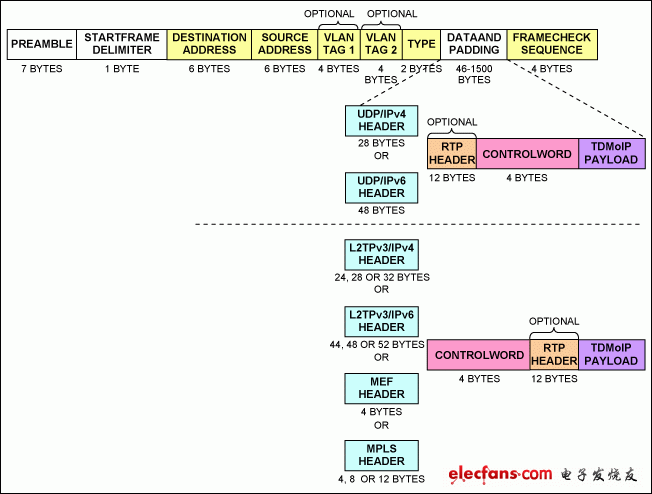
互 *** 作性是一个系统经过很少甚至无需系统 *** 作员介入而实现与其它系统协同工作的能力。系统的互 *** 作性使其有可能为其它系统提供服务或接受其它系统的服务,使得不同厂商的系统能够协同工作。本应用笔记介绍如何设置DS34S132 TDM-over-Packet (TDMoP) IC,使其与其它TDMoP器件实现互 *** 作。
引言
毋庸讳言,当今的通信系统需要不同设备和设备之间的复杂交互。随着技术的进步,互 *** 作性也变得更加重要。互 *** 作性是一个系统经过很少甚至无需系统 *** 作员介入而实现与其它系统协同工作的能力。系统的互 *** 作性使其有可能为其它系统提供服务或接受其它系统的服务,从而使不同厂商的系统能够协同工作。
本应用笔记着重介绍Maxim TDM-over-Packet (TDMoP) IC,DS34S132。文章介绍了在DS34S132与其他厂商TDMoP器件之间实现互 *** 作性的设置要求。
互 *** 作性要求
Maxim的TDMoP器件产生的数据包与其他厂商的TDMoP器件的报头信息可能不同。为了使TDMoP器件实现互 *** 作,用户需要了解器件的设置类型。Maxim器件的设置为以下之一:
-
IP/UDP/RTP/SAToP
-
IP/UDP/RTP/CESoPSN
-
MEF/RTP/CESoETH—非结构化(即MEF/SAToP)
-
MEF/RTP/CESoETH—结构化锁定(即MEF/CESoPSN)
-
MPLS/RTP/SAToP—非结构化(即MPLS/RTP/SAToP)
-
MPLS/RTP/CESoPSN—结构化锁定(即MPLS/RTP/CESoPSN)
每种TDMoP器件设置都有不同的报头。为了实现互 *** 作性,必须将来自于Maxim TDMoP器件的报头格式化,使其与其它器件的报头相同。这意味着用户需要比较TDMoP器件的报头,并查找格式差异。本应用笔记介绍如何利用Maxim的应用程序修改DS34S132 TDMoP器件的报头。文章还介绍了如何修改Maxim绑定配置,以接受协议相同但报头信息不同的数据包。
TDMoP格式
本节介绍TDM-over-Packet模块的功能描述。为了通过分组交换网络传输TDM数据,TDMoP器件将TDM数据封装为以太网数据包,如图1所示。TDMoP报头不同数据块的说明请参见表1。

图1. 以太网数据包格式的TDMoP封装。
表1. 以太网数据包结构
Field
DescripTIon
Preamble
A sequence of 56 bits (alternaTIng 1 and 0 values) used for synchronizaTIon. Gives components in the network TIme to detect the presence of a signal.
Start frame delimiter
A sequence of 8 bits (10101011) that indicates the start of the packet.
Destination and Source Addresses
The Destination Address field identifies the station or stations that are to receive the packet. The Source Address identifies the station that originated the packet. A Destination Address can specify either an "individual address" destined for a single station, or a "multicast address" destined for a group of stations. A Destination Address of all 1 bits refers to all stations on the LAN and is called a "broadcast address."
Type
Ether type
Data and padding
This field contains the data transferred from the source station to the destination station or stations. The maximum size of this field is 1500 bytes. A minimum size Ethernet packet is 64 bytes from the Destination Address field through the Frame Check Sequence. If the packet size of this field is less than 46 bytes, padding is used to bring the packet size up to the minimum length.
Frame check sequence
This field contains a 4-byte cyclical redundancy check (CRC) value used for error checking. When a source station assembles a packet, it performs a CRC calculation on all the bits in the packet from the Destination Address through the pad fields (that is, all fields except the preamble, start frame delimiter, and Frame Check Sequence). The source station stores the value in this field and transmits it as part of the packet. When the destination station receives the packet, it performs an identical check. If the calculated value does not match the value in this field, the destination station assumes that an error has occurred during transmission and discards the packet.
为了实现互 *** 作性,用户需要注意TDMoP报头的两个部分:
-
UDP/IPv4报头互 *** 作性
-
RTP报头互 *** 作性



 微信扫一扫
微信扫一扫
 支付宝扫一扫
支付宝扫一扫
评论列表(0条)